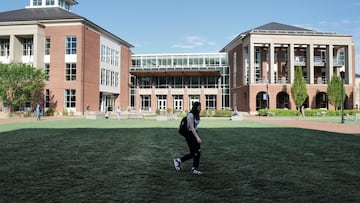Student loan debt: What is the Fresh Start program and how does it work?
For those borrowers struggling the most with repaying their student debt a new program aims to stave off the worst consequences.


The Fresh Start program aims to offer usually restricted benefits to student debt borrowers that have defaulted on their loans.
Its most important measures are access to federal student aid, such as loans and grants, as well as resumed eligility for other loans such as mortgages.
Currently, all defaulted borrowers have access to this, but for the benefits to continue beyond September 2024 then an application process must be completed. An estimated 7.5 million people are eligible, but borrowers must have defaulted on the loans before forbearance began on 13 March, 2020.
The program involves several steps.
Application process
You can apply for the Fresh Start program using one of three methods:
- Log in to your online account at myeddebt.ed.gov
- Call the Education Department at 800-621-3115 (877-825-9923 TTY) or your guaranty agency if your FFEL loan isn't held with the Education Department
- Write to P.O. Box 5609, Greenville, TX 75403, and include your name, Social Security number, date of birth and the statement: "I would like to use Fresh Start to bring my loans back into good standing."
Once you have enrolled in Fresh Start then, the federal government will transfer your defaulted loans from the Default Resolution Group to a loan servicer. Defaulted loans are set to “in repayment” status and, crucially, they will remove the record of your default from your credit report.
Enroll in a repayment plan
Once out of default you need to choose a repayment plan.
According to the Education Department, 80% of Fresh Start enrollees choose an income-driven repayment plan (IDR), where half of enrollees have a $0 monthly payment.
Make payments on time
During the on-ramp period instituted by the Biden Administration until September 2024, missing payments won’t lead to delinquency or default, but late payment charges might still apply. Furthermore, their loans will not be forwarded to collection agencies.
Once the on-ramp is over, payments have to resume or a borrower will be categorised as in delinquency again.
Which loans are eligible for the Fresh Start program?
Related stories
Fresh Start is available only to borrowers with federal student loans including direct loans, government-held Perkins loans, government-held FFELP loans, and privately held FFELP loans.
These loans are not eligible:
- Defaulted Perkins Loans held by schools
- Defaulted Health Education Assistance Loan Program loans
- Student loans remaining with the US Department of Justice for ongoing litigation
- Direct Loans that default after the end of the COVID-19 student loan payment pause
- FFEL Program loans that default after the end of the COVID-19 student loan payment pause

